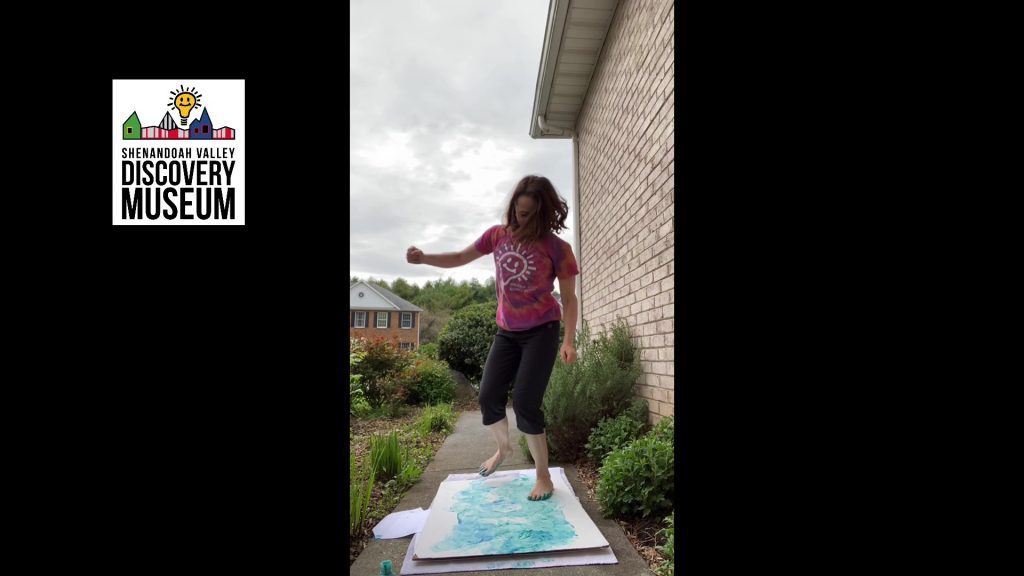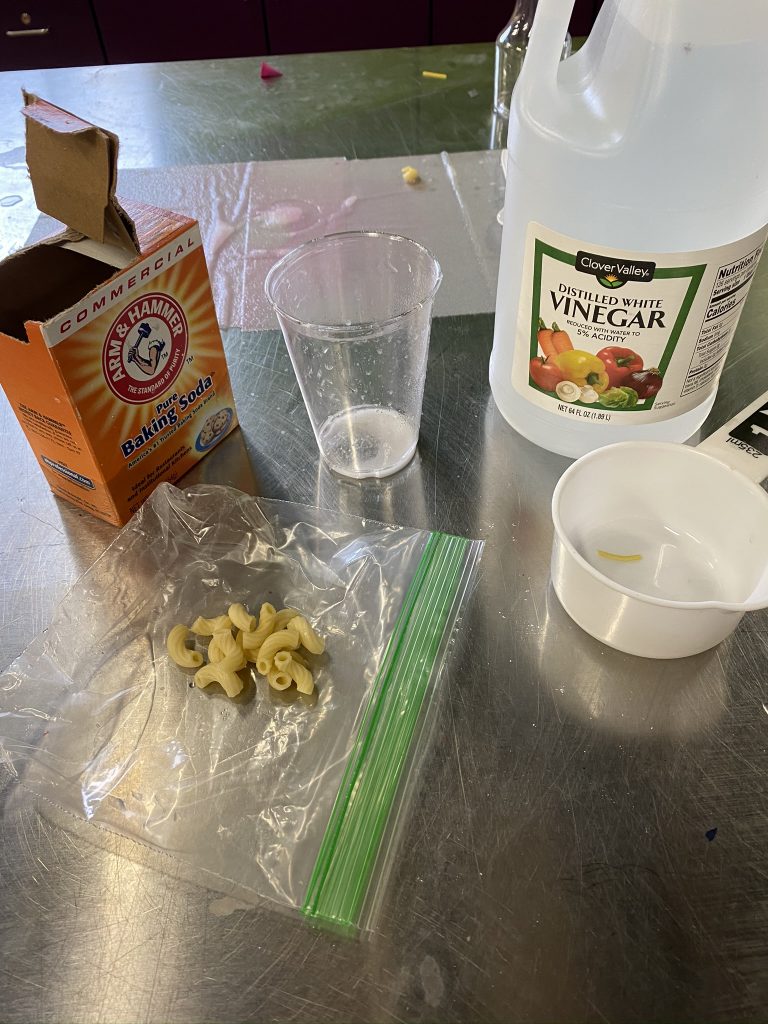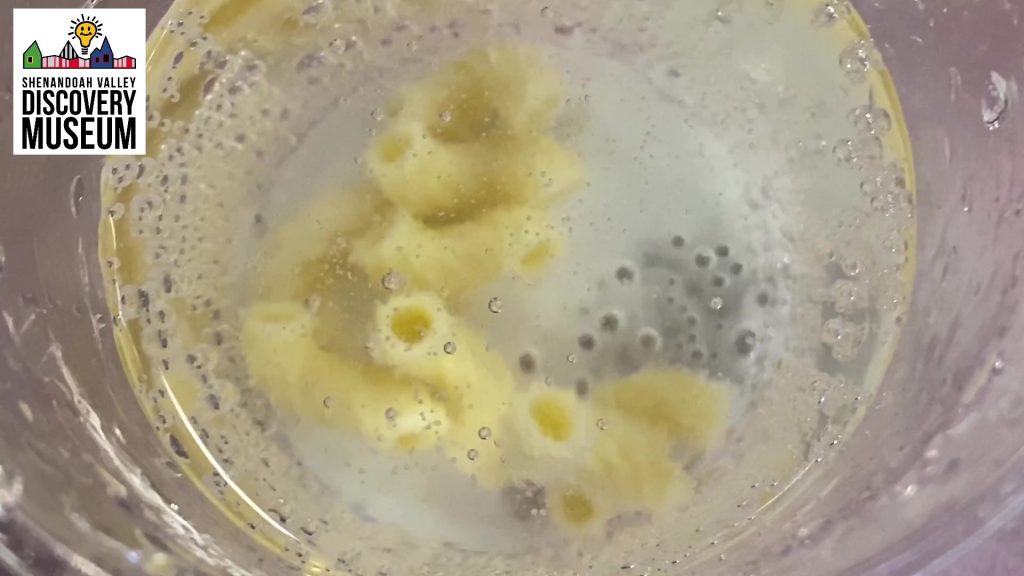Gotta Dance! A Celebration of International Dance Day
Today, we celebrate International Dance Day as we dance, dance, dance our blues away! From having a messy freeze dance art party to making pasta noodles dance in the science kitchen to meeting real-live dancers and trying new steps, we are all about twisting and turning and finding new ways to feel happy and playful! These activities include things that will help your child develop fine and gross motor skills, problem-solving and engineering skills, and can help them engage in cooperative play, while fostering creativity and perseverance. Each theme also comes with recommended literature and movie connections. Feel free to throw in your own activities that might relate, and don’t forget to post your results to social media and tag @discoverymuse to share with everyone else!
Art/Fine Motor Activity: Freeze Dance Art Party

For this activity, you’ll need:
- Big sheet of paper
- Frisbee or flat pan to hold paint
- Water color or tempera paint
- Bare Feet
- Music
- A Sense of Fun
- And a Bucket of Water/Towel to clean your feet after
Directions:

- Do this activity outside to contain the mess!
- Put on some music! Change it up, try different beats and different styles.
- Pour the paint into the frisbee or pan.
- Step into the paint (you can even use a different color for each foot).
- Step onto the paper.
- Dance to the music until it stops!
- Repeat until the paper is full.
- You can use your paper as wrapping paper or note cards later.
Science Kitchen Fun: Dancing Pasta

For this activity, you will need:
- Uncooked pasta
- 1 cup of water
- 2 teaspoons of baking soda
- 5 teaspoons of vinegar
- a tall clear glass (this part is important)
Directions:
- Pour a cup of water into a tall clear glass.
- Add two teaspoons of baking soda to the water.
- Stir the mixture together until the baking soda has dissolved into the water.
- Add uncooked pasta (about 6-8 pieces) into the glass of water and dissolved baking soda. (The pasta should sink to the bottom).
- Add 5 tsp vinegar to the solution in the glass. Observe as the pasta at the bottom of the glass begins to pop up and dance around!
- As the pasta dance party begins to slow down, add a little more vinegar to the solution to keep the dance party going!
Big Ideas: What’s Happening?

What turns your pasta pieces into dancing kings and queens is the reaction between the baking soda and vinegar. When these chemicals react, they produce water and carbon dioxide. Carbon dioxide floats to the top of the glass in the form of bubbles, which lifts the pasta on the way up (kind of like a life jacket or swim floaties).
What’s Happening: We’re basically working with Archimedes’ Principle here (the buoyant force exerted on water is equal to the weight of the water that is displaced). Since the surface of the noodles is rough, tiny bubbles of carbon dioxide gas are attracted to it. These bubbles increase the volume of the noodle, but don’t add much to its mass. Since the noodles now have a greater volume, they displace more water, causing the fluid to exert a greater buoyant force. The buoyant force of the surrounding water is what pushes the noodles to the top.
Once the noodles reach the top, the bubbles pop upon exposure to the air. This makes the noodles more dense, causing them to sink. As more bubbles adhere to the noodles, the density of the noodles decreases and they rise to the surface again. This experiment very clearly shows that an increase in volume (as long as the mass increase is negligible) will lead to a decrease in density. The bubbles that attach themselves to the noodles are like little life jackets that make the noodles more buoyant by increasing their volume.
Physical Activity: Dance, Dance, Dance!
Get some of those wiggles out while learning a little about dance.
Ho’onani feels in-between. When Ho’onani finds out that there will be a school performance of a traditional kāne hula chant, she wants to be part of it. But can a girl really lead the all-male troupe? Ho’onani has to try…Based on a true story, Ho’onani: Hula Warrior is a celebration of Hawaiian culture and an empowering story of a girl who learns to lead and learns to accept who she really is — and in doing so, gains the respect of all those around her.
Conversation Starters and Research Questions
Let’s learn some more about famous dancers. There are so many inspirational dancers from so many backgrounds and cultures. Pick a couple to investigate further. Where possible, we’ve included a link to a read aloud, as well as video clips that show samples of the dancer’s work.
Ready to Fly: How Sylvia Townsend Became the Bookmobile Ballerina written by Lea Lyon and Alexandria LaFaye, illustrated by Jessica Gibson.
When Sylvia Townsend saw Swan Lake on TV, she was captivated. She borrowed books about dance from the bookmobile and taught herself — and picked the skills up so quickly that she started teaching other kids, too! When her fourth grade teacher offered to pay for lessons, Sylvia discovered another, unexpected obstacle: in the 1950s, dance studios won’t teach an African American girl. But eventually, Sylvia found a teacher who did appreciate her talent — and she grew up to teach other children who are ready to fly! determination — and a reminder of the value of libraries.
Firebird, written by Misty Copeland, illustrated by Christopher Myers. A young ballerina looks up at her idol and despairs: how can she ever hope to achieve such heights? But her idol speaks back to her, telling her about the thousands of hours of practice that it took to become the Firebird — and the dreams that every generation inspires in the next. The book includes an author’s note about Copeland’s ballet journey, as well as her desire to provide diverse role models for girls.
- Swan Lake with Misty Copeland and the LA Philharmonic
- Misty Copeland in The Nutcracker
- Clips from Misty Copeland’s A Ballerina’s Tale Documentary
Danza! Amalia Hernández and Mexico’s Folkloric Ballet by Duncan Tonatiuh. As a child, Amalia always thought she would grow up to be a teacher, until she saw a performance of dancers in her town square. She was fascinated by the way the dancers twirled and swayed, and she knew that someday she would be a dancer, too. She began to study many different types of dance, including ballet and modern, under some of the best teachers in the world. Hernández traveled throughout Mexico studying and learning regional dances. Soon she founded her own dance company, El Ballet Folklórico de México, where she integrated her knowledge of ballet and modern dance with folkloric dances. The group began to perform all over the country and soon all over the world, becoming an international sensation that still tours today.
Tallchief: America’s Prima Ballerina by Maria Tallchief with Rosemary Wells, illustrated by Gary KelleyGrowing up on the Osage Indian reservation, Maria Tallchief was a gifted pianist and dancer. According to Osage tradition, women are not permitted to dance, but Maria’s parents recognized her gifts and allowed her to break the rule. Then when Maria reached the age of twelve, her father told her it was time to choose between her two loves. Maria chose ballet.
It was a decision that would change not only the course of her life, but the face of classical ballet in America. The fascinating story of Maria Tallchief’s rise to become America’s prima ballerina will captivate young readers.
- Maria Tallchief—Osage Native And America’s First Prima Ballerina: Hidden Figuras
- Maria Tallchief in George Balanchine’s Firebird
Alvin Ailey, written by Andrea Pinkney, illustrated by Brian Pinkney. “This markedly talented husband-and-wife team offers a warm profile of dancer and choreographer Alvin Ailey . . . intertwining Ailey’s alleged thoughts and conversations with facts about his childhood, his introduction to the world of dance . . . and his founding of the Alvin Ailey American Dance Theater in 1958.”–“Publishers Weekly,” starred review. Full color.
Rap a Tap Tap: Here’s Bojangles – Think of That! By Diane Dillon, illustrated by Leo Dillon.This simple book for young children has the added bonus of describing the life of a ground-breaking African-American tap dancer. Bill “Bojangles” Robinson was one of the most popular entertainers of the 1920s-30s. People said he “talked with his feet,” and in the Dillons’ graceful paintings of old New York, he dances from page to page to the tune of a toe-tapping rhyme. Rap a tap tap–think of that!
- Bill “Bojangles” Robinson Stair Dance (1932)
- A sampling of some of the best male tap dancers
- A sampling of some of the best female tappers
Jose! Born to Dance: The Story of Jose Limon by Susanna Reich, illustrated by Raul Colon. José was a boy with a song in his heart and a dance in his step. Born in Mexico in 1908, he came into the world kicking like a steer, and grew up to love to draw, play the piano, and dream. José’s dreaming took him to faraway places. With his heart to guide him, José left his family and went to New York to dance. He learned to flow and float and fly through space with steps like a Mexican breeze. When José danced, his spirit soared. From New York to lands afar, José Limón became known as the man who gave the world his own kind of dance.
- Jose Limon — original footage of The Moor’s Pavane
- Bach’s Chaconne, performed by Johnny Gandelsman and the Limón Dance Company
Book and Movie Connections
Because we know you’re stuck at home with limited access to movies and books, we tried to compile a list that connects to today’s theme that you might already have in your collection or be able to access online. There are so many wonderful dance movies out there, from Newsies to Singing in the Rain to Step Up to Happy Feet. Spend some time looking for the ones that will best suit your family’s interests and needs.
When Mama falls asleep on the sofa, it’s an opportunity for Dad and his little girl to have a swooping, twirling dance, just the two of them. This energetic book is perfect for reading aloud… or dancing to!
Baby Dance by Ann Taylor, illustrated by Marjorie van Heerden. When Mama falls asleep on the sofa, it’s an opportunity for Dad and his little girl to have a swooping, twirling dance, just the two of them. This energetic book is perfect for reading aloud… or dancing to!
Kitchen Dance by Maurie Manning.When this little girl wakes up at night, she hears enticing noises from downstairs. Soon, she and her brother are sneaking downstairs, only to spot their mother and father singing and dancing as they clean up the kitchen: “¡Como te quiero! Oh, how I love you!”
Zombelina by Kristyn Crow, illustrated by Molly Idle. Zombelina’s love of dance is appreciated by her friends and family — but when she joins a ballet class for real girls, a bout of stage fright leaves her onstage moaning and staggering like, well, a zombie… and scares away most of the audience. Those who are left, though, are the ones who appreciate exactly who Zombelina is.
Dance Is For Everyone by Andrea Zuill. When a 450 pound alligator shows up at the ballet barre one day, Mrs. Iraina and her students don’t know what to say. Fortunately, it appears that the alligator is genuinely interested in dancing, and since they can’t remove her — would YOU try to kick her out? — they decide to call her Tanya and work her natural talents and wild-swinging tale into the choreography for their recital dance.
Dancing in the Wings by Debbie Allen, illustrated by Kadir Nelson. Sassy loves ballet more than anything, but she worries that her large feet, her long legs, or her big mouth will keep her from reaching her dream.Inspired by Debbie Allen’s own experiences as a young dancer, this story encourages empathy, but also captures the joy a dancer who finds her own way to soar.
Jingle Dancer by Cynthia Leitich Smith, illustrated by Ying-Hwa Hu and Cornelius Van Wright. After seeing a video of Grandmother Wolfe jingle dancing, Jenna, a Muscogee girl, wants to continue her family’s tradition at the upcoming powwow. But how can she get enough jingles for her dress? This book not only celebrates not only the joy of dancing, but also the pride of continuing family and cultural traditions.
Opportunities to try dance for yourself…
- KidzBop Dance Along Videos
- Just Kids Dance! Bingo and Other Songs
- Toddler/Preschool Frozen Dance Class
- Armstrong Irish Dance Academy (Winchester VA)


